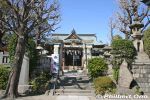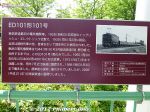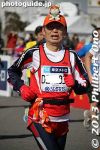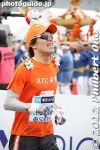|
|
|
|

Karasaki Pine Tree in Kenrokuen Garden, Kanazawa, Ishikawa Pref.
|
|

Marker and side road to Lord Gamo (Gamoh) Ujisato's gravesite. Near Aizu-Wakamatsu City Hall. Gamo Ujisato (1556-1595) was a feudal lord from Hino, Shiga Pref. He built Tsurugajo Castle and named the town Wakamatsu, after a place in his hometown.
|
|

Ujisato was married to Oda Nobunaga's second daughter Fuyuhime. He died at age 40. One theory says that he was poisoned by Toyotomi Hideyoshi. Entrance to Lord Gamo Ujisato's gravesite within Kotokuji temple in Aizu-Wakamatsu, Fukushima..
|
|

Entrance doors to Lord Gamo Ujisato's gravesite within Kotokuji temple which is a Zen temple of the Rinzai Sect.
|
|

Karasaki Pine Tree in Kenrokuen Garden, Kanazawa, Ishikawa Pref.
|
|
|

Grounds of Lord Gamo Ujisato's gravesite within Kotokuji temple. Since Ujisato was a Christian lord, it is ironic that he be buried in a Buddhist temple in Kyoto and Aizu-Wakamatsu.
|
|

Lord Gamo Ujisato's grave. This is a secondary grave, where his hair is buried. His main grave is at a temple in Kyoto where he died at age 40.
|
|

Tahoto Pagoda at Gokokuji temple in Bunkyo, Tokyo. Built in 1938 modeled after the original Tahoto Pagoda at Ishiyama-dera temple in Otsu, Shiga Prefecture. 多宝塔
|
|
|
|

Tahoto Pagoda and Gekkoden Hall at Gokokuji temple in Bunkyo-ku, Tokyo
|
|

Escort ship Kama Hele flying the Japanese, Hawaiian, and Yanmar flags at Yokohama.
|
|

Gekkoden Hall (Important Cultural Property). It was moved here from Miidera temple in Otsu, Shiga Prefecture. Now it serves as a tea ceremony headquarters 茶道本山. 月光殿
|
|

Oguchi Taro Statue and Biwako Shuko no Uta Song Monument. On the shore of Lake Suwa, Okaya, Nagano. 歌碑と小口太郎銅像This was where I first heard the song, "Biwako Shuko no Uta." In May 2004, I was in Suwa, Nagano Pref. to see and photograph the Onbashira Festival (held every 6 years). My hotel was in the neighboring city of Okaya on the shores of Lake Suwa.
I walked around the lake and came across this statue of Taro Oguchi and song monument. I was very surprised when I saw the word "Biwako" (Lake Biwa). This was Nagano, not Shiga, so it was most unexpected to see "Biwako" here. I read the song lyrics on the monument and was surprised and delighted to see the names of well-known places in Shiga.
The monument even had music box (seen on left) where you could hear three versions of the song. I immediately found it intriguing.
|
|

Hiko-nyan from Shiga Prefecture at 2016 Tokyo Marathon.
|
|

Hiko-nyan at 2016 Tokyo Marathon.
|
|

Song monument with the entire lyrics of Biwako Shuko no Uta. On the shore of Lake Suwa in Okaya, Nagano. 琵琶湖周航の歌 全歌詞碑
|
|

Butsuden Buddha Hall, Gotokuji temple, Setagaya, Tokyo. This was renovated by Lord Ii Naotaka's wife and oldest daughter. 仏殿
|
|

Roof ridge of Butsuden includes the family crest for the Ii Clan. Gotokuji temple.
|
|

Gotokuji temple's Hondo Main Hall, Setagaya, Tokyo. Ii clan's family temple. 本堂
|
|

Ii clan crest on rain water barrel under the roof of Gotokuji temple Hondo Hall, Setagaya, Tokyo.
|
|

Shelf for beckoning cats, maneki neko. Gotokuji temple, Setagaya, Tokyo.
|
|

Gotokuji temple votive tablet. This cat connection with Ii Naotaka gave rise to Hiko-nyan, the official mascot of Hikone, Shiga Prefecture.
|
|

Only Ii Naosuke's grave has a sign explaining about him.
|
|

Grave of Lord Ii Naosuke (1815-1860), the lord of Hikone Castle in Shiga Prefecture and Chief Minister of the Tokugawa Shogun's government. Gotokuji temple, Setagaya-ku, Tokyo. 井伊直弼の墓 豪徳寺
|
|

Grave of Lord Ii Naohide (1755-1789). He served as Tairo Chief Minister in the Tokugawa government. Gotokuji temple, Setagaya, Tokyo 井伊直幸
|
|

Grave of Lord Ii Naotaka (1590-1659), 2nd lord of Hikone, Shiga. Gotokuji temple, Setagaya, Tokyo 井伊直孝
|
|

Grave of Lord Ii Naoyoshi (1727-1754), Gotokuji temple, Setagaya, Tokyo 井伊直禔
|
|

Grave of Lord Ii Naotsune (1693-1710), Gotokuji temple, Setagaya, Tokyo 井伊直恒
|
|

Grave of Lord Ii Naonori (1848-1904), Gotokuji temple, Setagaya, Tokyo 井伊直憲の墓
|
|

And here's Hiko-nyan!! Direct from Hikone, Shiga Prefecture, Japan in the 30th Pan-Pacific Festival (also called “Matsuri in Hawaii”) parade on June 7, 2009 from 5 pm to 7 pm along Kalakaua Ave. in Waikiki.ひこにゃんが僕の故郷であるハワイにも登場したことはとても嬉しいかったけど、写真をよく見ると、どこも「Shiga」とか「Hikone」が表示していないの。ただの「Hikonyan–Ii Naosuke-Gateway to the Future」しか載っていない。それは意味が不明。最低、FROM HIKONE, SHIGA, JAPANとか書けばいいな。せっかく皆が見るので。市の職員がPRの感覚が鈍い。
|
|

Hiko-nyan in Hawaii!!
|
|

He looks great with a lei!! So nice to see this in my native Hawaii. Wish I was there to see it.
|
|

写真をよく見ると、どこも「Shiga」とか「Hikone」が表示していないの。ただの「Hikonyan–Ii Naosuke-Gateway to the Future」しか載っていない。それは意味が不明。
|
|

最低、FROM HIKONE, SHIGA, JAPANとか書けばいいな。せっかく皆が見るので。市の職員がPRの感覚が鈍い。こんな基本的なこと、なんで考えてくれないの??
|
|

Shiga's Bay Waves, Horikiri Iris Garden 滋賀浦波
|
|

Shiga's Bay Waves, Horikiri Iris Garden 滋賀浦波
|
|

Japanese, Hawaiian, and Yanmar (sponsor) flags on the Kama Hele, escort boat for Hokule'a. (Yanmar is a marine engine maker from Shiga Prefecture.)
|
|

In 1884, former retainers of the Hikone domain in Omi (Shiga Prefecture) bought the land here and the Ii family owned the land.
|
|

Kamonyama Park in Yokohama has a statue of Ii Naosuke, lord of Hikone Castle in Shiga Prefecture who served as the Chief Minister of the last Tokugawa government in the 19th century.
|
|

The original statue of Lord Ii Naosuke was installed in 1909 in Kamonyama Park. However, it was melted down during World War II for its metal. This statue was reconstructed in 1954 to mark the 100th anniversary of Yokohama's port opening..
|
|

Statue of Ii Naosuke, lord of Hikone Castle in Shiga Prefecture in Kamonyama Park, Yokohama. He was a key figure in opening Japan to the West. As a result, Yokohama was one of Japan's first ports opened to foreigners.
|
|

Statue of Ii Naosuke, lord of Hikone Castle in Shiga Prefecture in Kamonyama Park, Yokohama. In 1914, the Ii family donated Kamonyama Park to the city of Yokohama.
|
|

The name "Kamonyama" comes from Ii Naosuke's official governmental rank of "Kamon-no-kami" (掃部頭).
|
|

Since Kamonyama Park is on a hill, it overlooks the Minato Mirai skyscrapers.
|
|
|

Kita Biwako steam locomotive
|
|

Koka ninja greets visitors to Matsumoto Castle in Matsumoto, Nagano.
|
|

Shirahige Shrine in Higashi Mukojima, Sumida-ku, Tokyo. "Shirahige" literally means "white beard," a sign of old age and longevity. The shrine worships Sarutahiko Ōkami for strength and guidance.
|
|

Shirahige Shrine in Higashi Mukojima, Sumida-ku, Tokyo is also a branch shrine of Shirahige Shrine in Takashima, Shiga Prefecture. 白鬚神社
|
|

Scale model of the Three-Story Pagoda at Saimyoji temple in Shiga Prefecture. Inside Nakayama Hokekyoji temple in Ichikawa, Chiba.
|
|

Scale model of the Three-Story Pagoda at Saimyoji temple in Shiga Prefecture. Inside Nakayama Hokekyoji temple in Ichikawa, Chiba.
|
|
|
|

The city of Nagahama boldly opened a little museum in Ueno, Tokyo called “Biwako Nagahama Kannon House” (びわ湖長浜 KANNON HOUSE) on March 21, 2016.
|
|

The museum is small, but nice. It has only one medium-size room divided into the kannon exhibition space and a mini theater showing a video about Nagahama.
|
|
|

“Biwako Nagahama Kannon House” (びわ湖長浜 KANNON HOUSE)
|
|

It exhibits one precious kannon Buddha statue (Goddess of Mercy) brought over from Nagahama, Shiga Prefecture. The exhibit changes every two months so Tokyoites can see six different kannon statues from Nagahama every year.
|
|

This Kannon is from Sonju-in temple (尊住院) in Nagahama’s Kawamichi-cho district.
|
|

The small exhibition space is enclosed by a wooden, temple-like fence modeled after a Kannon-do (観音堂) or small kannon worship hall. The wood is hinoki cypress from Nagahama.
|
|

Adjacent room shows a video about Nagahama Kannon.
|
|

Mt. Ibuki in Shiga Prefecture in the Railway model diorama at SCMAGLEV and Railway Park in Nagoya.
|
|

Mt. Ibuki in Shiga Prefecture in the Railway model diorama at SCMAGLEV and Railway Park in Nagoya.
|
|

0 Series Tokaido shinkansen's windows have various pictures along the shinkansen. This is Mt. Ibuki. Railway Museum in Saitama.
|
|

0 Series Tokaido shinkansen's windows have various pictures along the shinkansen. This is Mt. Ibuki. Railway Museum in Saitama.
|
|

Pine tree at Shinagawa-juku's Honjin. The pine tree came from Tsuchiyama-juku in Koka, Shiga Prefecture.
|
|

Sign explaining about the pine tree. Tsuchiyama in Shiga Prefecture was the 49th post town on the Tokaido Road.
|
|

Hotel New Otani in Tokyo used to be the site of the Ii clan's residence. They were warlords from Hikone in Shiga Prefecture.
|
|

Marker and sign indicating the site of the Ii clan residence in Edo (Tokyo) during the feudal era.
|
|

Marker and sign indicating the site of the Ii clan residence in Edo (Tokyo) during the feudal era.
|
|

ED101 class electric locomotive – No. 101. Built in 1930 for Tobu, used by Ohmi Railway during its final years, and brought back to Tobu in January 2009.Displayed at Tobu Museum in Sumida Ward, Tokyo.
|
|

Tobu's ED101 class electric locomotive – No. 101 when used by Ohmi Railway in Shiga Prefecture.
|
|

About the ED101 class electric locomotive – No. 101.
|
|

Hiko-nyan at 2014 Tokyo Marathon.
|
|

Hiko-nyan from Hikone, Shiga at 2013 Tokyo Marathon.
|
|

Hiko-nyan at 2013 Tokyo Marathon.
|
|

Hiko-nyan from Hikone, Shiga Prefecture. A helmeted samurai cat at 2011 Tokyo Marathon.
|
|

Hiko-nyan mascot from Hikone, Shiga Prefecture at 2012 Tokyo Marathon.
|
|

Hiko-nyan mascot from Hikone, Shiga Prefecture at 2012 Tokyo Marathon.
|
|

In 1591, Lord Gamo Ujisato (from Hino, Shiga) built a 7-story castle tower and renamed it Tsuruga-jo Castle. "Tsuru" means crane. A major earthquake in 1611 damaged the tower, so Lord Kato Akinari rebuilt the castle tower with 5 stories in 1639.
|
|

Aizu-Wakamatsu (Tsuruga-jo) Castle, Fukushima Pref. The reconstructed castle tower (ferro-concrete) is based on the 5-story castle tower Kato Akinari built in 1639. "Wakamatsu" was named after a place in Hino, Shiga by Ujisato.
|
|

Tanemaru on Hikone no Yoi-nyanko (alias Hiko-nyan) at at EXPO Y150 in Yokohama.
|
|

Hikone no Yoi-nyanko and Tanemaru at EXPO Y150 in Yokohama.
|
|

Souvenir at EXPO Y150 in Yokohama.
|
|
|
|
|